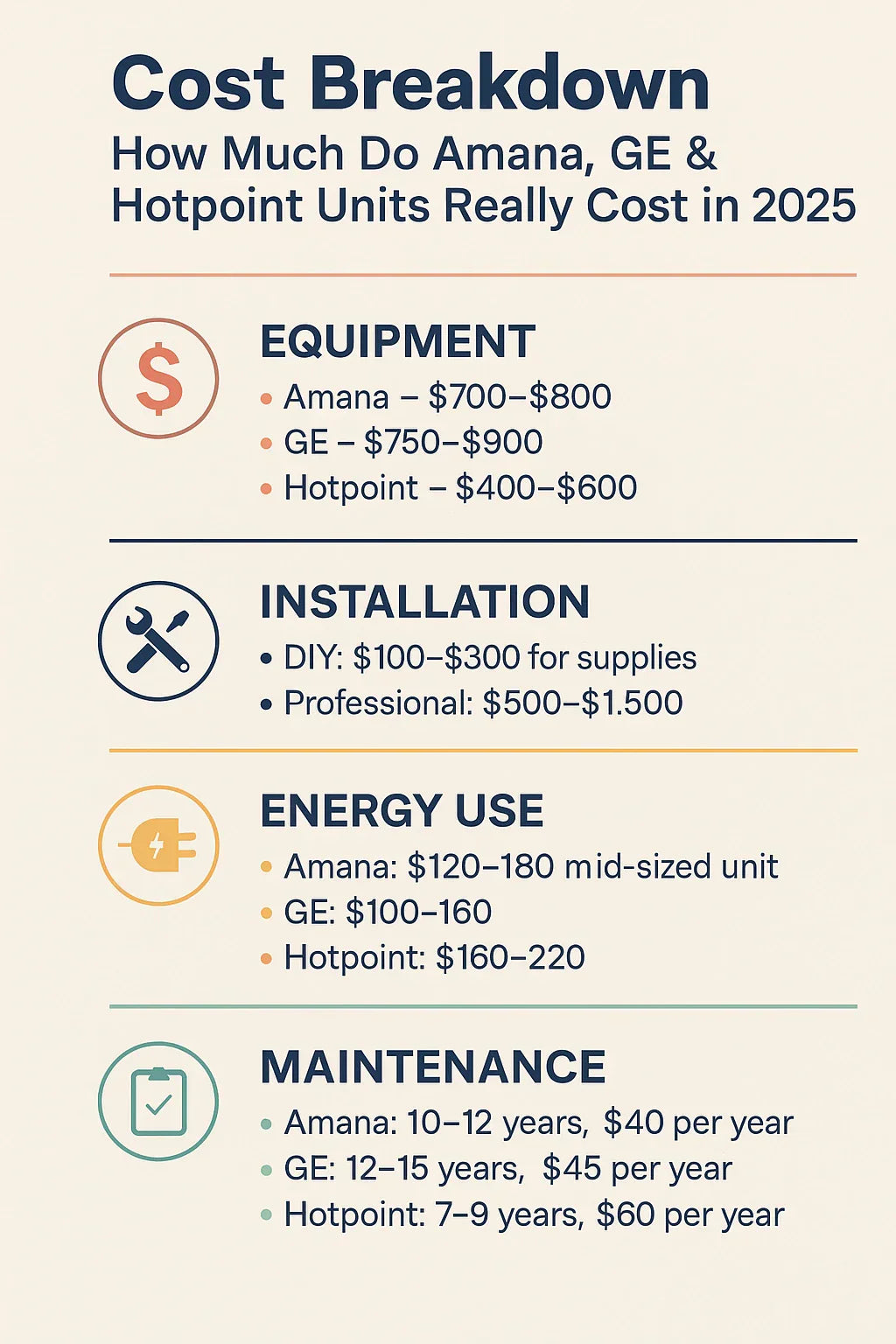When you’re shopping for a new heating or cooling unit, the first number you see is the sticker price. But as most homeowners quickly discover, that’s only the starting point. The real cost of owning an Amana, GE, or Hotpoint unit in 2025 includes:
-
The equipment itself
-
Installation costs (DIY or professional)
-
Accessories (wall sleeves, thermostats, drain kits, etc.)
-
Energy use (how much it costs to run the unit each month)
-
Maintenance and repairs over time
In this Samantha-style guide, I’ll walk you through each layer of the cost puzzle—so you can make a decision based not only on the price tag, but on the lifetime value of your investment.
🏷️ Equipment Costs: Amana vs. GE vs. Hotpoint
Here’s what you can expect to pay upfront in 2025.
| Brand | Entry-Level Units | Mid-Range Units | Premium Units |
|---|---|---|---|
| Amana | $700–$800 | $1,000–$1,400 | $1,800+ |
| GE | $750–$900 | $1,200–$1,600 | $2,000+ |
| Hotpoint | $400–$600 | $700–$900 | $1,100 |
🔴 Amana – Solidly mid-range. You’re paying for durability, stronger warranties, and EnergyStar performance on many models.
🔵 GE – Slightly higher than Amana, especially for Zoneline PTAC units. But these are built to last and highly efficient.
⚪ Hotpoint – The budget option. Lowest entry point, but also the shortest warranties and average lifespans.
🔧 Installation Costs: DIY vs. Pro
The next cost layer is installation. Here’s what you might expect:
-
DIY Installation
-
Wall units and PTACs can sometimes be DIY-friendly if you’re handy.
-
Expect costs of $100–$300 for supplies (sealants, brackets, electrical hardware).
-
Risk: mistakes in sealing or wiring can cost more down the road.
-
-
Professional Installation
-
Through-the-wall AC / PTAC installation: $500–$1,500, depending on wall modifications.
-
Electrical work (for 230V units): $200–$500.
-
If you’re replacing an old unit with the same size, costs drop significantly.
-
👉 The U.S. Department of Energy notes that proper installation is critical to efficiency—a poorly installed unit can reduce performance by up to 30% .
🧩 Accessories & Add-Ons
A unit alone won’t always do the job—you may need accessories:
-
Wall Sleeves – $120–$250 (required for most through-the-wall units).
-
Exterior Grilles – $60–$100.
-
Thermostats / Smart Controls – $50–$200 (Amana and GE support Wi-Fi or smart integration; Hotpoint is more basic).
-
Drain Kits – $20–$50.
-
Electric Heat Kits – $120–$250 for models offering supplemental heating.
💡 Pro tip: Always check brand compatibility before buying accessories—Amana, GE, and Hotpoint may use different sleeve dimensions.
👉 See EnergyStar’s buying guide for room AC accessories.
⚡ Energy Use & Utility Bills
This is the hidden cost that adds up the most over time.
-
Amana
-
SEER ratings: 13–15.
-
Many EnergyStar models.
-
Average annual cost to run: $120–$180 per year (for a mid-sized unit).
-
-
GE
-
Higher EER/CEER ratings than Amana.
-
Often the most efficient of the three.
-
Average annual cost to run: $100–$160 per year.
-
-
Hotpoint
-
Efficiency is not a strong point.
-
Fewer EnergyStar certifications.
-
Average annual cost to run: $160–$220 per year.
-
👉 Use the official EnergyStar Room AC calculator to estimate costs for your zip code and utility rates.
🛠️ Maintenance & Long-Term Costs
Another layer: keeping the unit running.
Amana
-
Known for durability.
-
Filter replacements: $20–$40 annually.
-
Service calls (rare): $150–$300.
-
Lifespan: 10–12 years.
GE
-
Strong reliability.
-
Filters: $20–$40 annually.
-
Smart tech = occasional software/service updates.
-
Lifespan: 12–15 years.
Hotpoint
-
Lower-cost materials mean shorter lifespans.
-
Filters: $15–$30 annually.
-
Repairs: often not worth it beyond warranty.
-
Lifespan: 7–9 years.
👉 Check DOE’s HVAC maintenance guidelines for seasonal care tips.
🛡️ Warranties: Built-In Cost Protection
-
Amana → 5–10 years on parts & compressors (depending on model).
-
GE → Typically 1-year limited warranty, with optional extended coverage.
-
Hotpoint → Basic 1-year parts & labor.
💡 Warranty value matters: a $300 compressor repair covered by Amana’s longer warranty could save you more than Hotpoint’s entire unit price difference.
👉 Review Amana warranty details before purchase.
📊 Lifetime Cost Comparison
Here’s what the 10-year total cost might look like for a mid-range unit from each brand (equipment + install + energy + maintenance).
| Brand | Equipment + Install | 10-Year Energy | 10-Year Maintenance | Total 10-Year Cost |
|---|---|---|---|---|
| Amana | ~$1,600 | ~$1,500 | ~$400 | ~$3,500 |
| GE | ~$1,800 | ~$1,300 | ~$450 | ~$3,550 |
| Hotpoint | ~$1,200 | ~$1,900 | ~$600 | ~$3,700 |
💡 Takeaway: While Hotpoint looks cheapest upfront, its higher energy use and shorter lifespan often make it the most expensive in the long run.
🏠 Best Fit by Budget & Lifestyle
-
Amana → For homeowners who plan to stay put and want long-term reliability.
-
GE → For rental properties, hotels, or condos where energy efficiency and longevity matter most.
-
Hotpoint → For budget-conscious buyers or landlords needing quick, affordable solutions.
📌 Final Thoughts from Samantha
When you stack the numbers side by side, the choice becomes clearer:
-
If you want the best warranty + value balance, choose Amana.
-
If you prioritize efficiency and long-term performance, go with GE.
-
If you just need a cheap solution now, Hotpoint fits the bill—but don’t expect it to last as long.
👉 Always calculate the lifetime cost, not just the sticker price. That’s the difference between a smart investment and a money pit.
In the next topic we will know more about: Installation Guide: What Samantha Learned Putting in a GE Wall Unit







